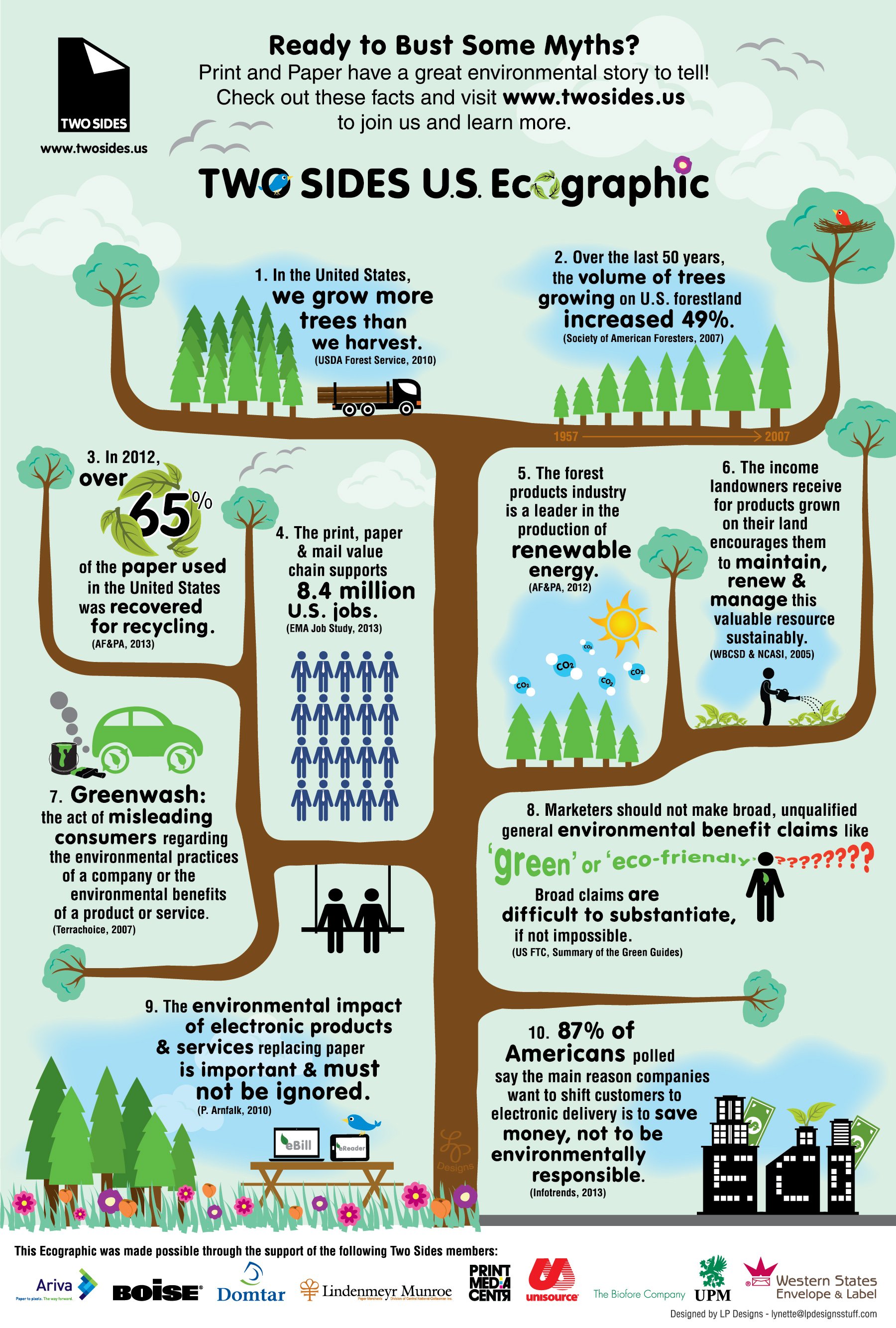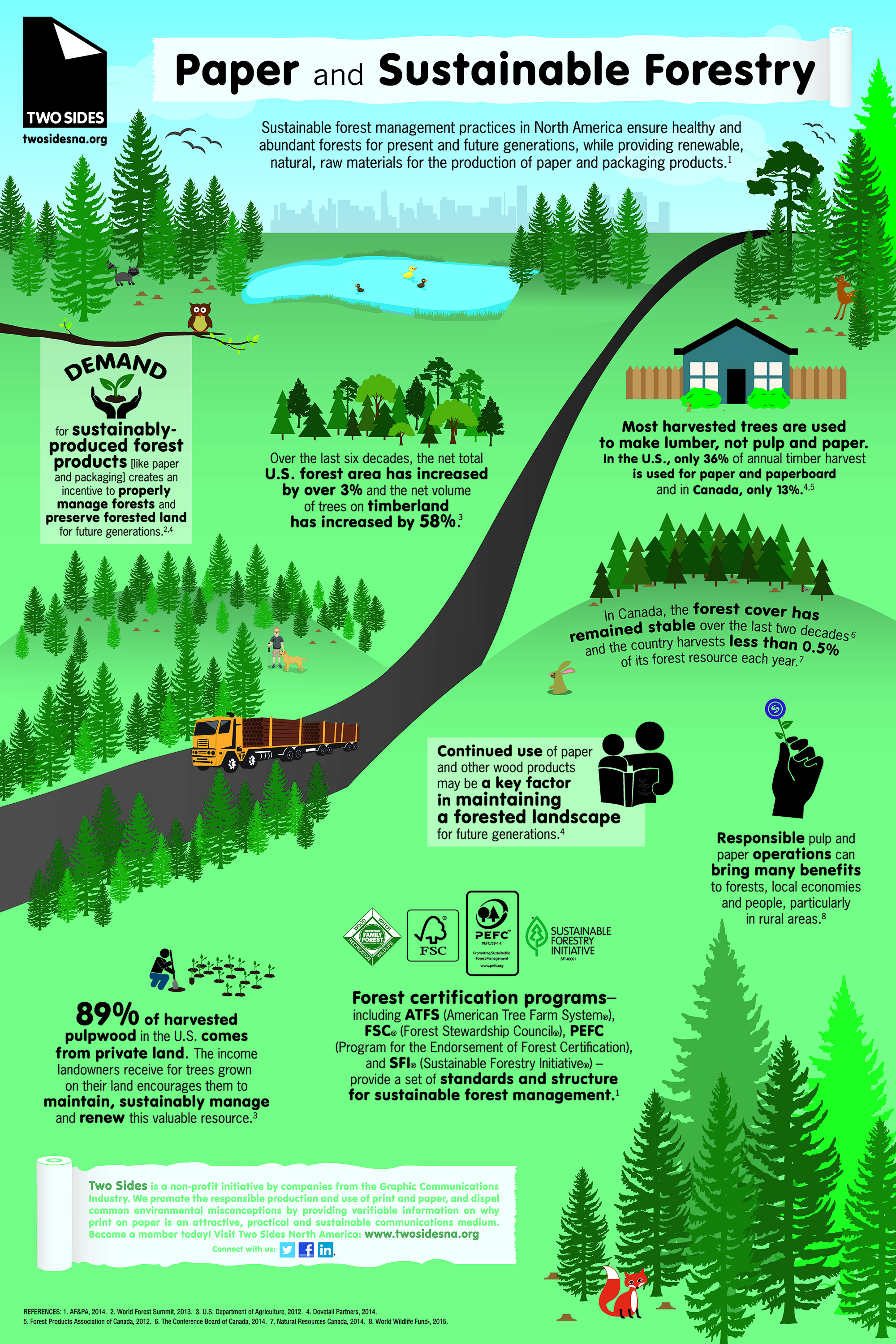The wise use of the world’s forests is critical to our survival and a healthy environment. Forests are vital in maintaining life as we know it, as they:
cover one third of the earth’s land and absorb massive amounts of carbon dioxide making them a major instrument in mitigating climate change,
- absorb airborne impurities and give off oxygen allowing us to breathe clean air,
- protect our watersheds and provide us with clean water,
- are home to the majority of the world’s terrestrial species, and many people around the world—1.6 billion according to the World Wildlife Fund—depend on forests for their livelihoods.
We are often led to believe that using paper is bad for the environment and that forest practices always lead to eroded lands and fewer trees—not so in North America! As the Two Sides infographic illustrates:
What does green mean?
At Wordtech, we believe that being sustainable means working in a way that we can be successful today, while eliminating the problems for tomorrow.
More than simply choosing recycled paper or soy inks, smart sustainable printing solutions take into consideration almost every aspect of the design and printing process. Sure it involves paper and ink, but it also involves the process. It can involve how you design your project, the location of your vendors and resources, how much energy is consumed and how a company conducts business on a day-to-day basis.
 Smart and stunning solutions for sustainable printing
Smart and stunning solutions for sustainable printing
When planning and designing your print materials, it may also be helpful to consider the following tips:
- Choose recyclable, renewable, and biodegradable materials. While this tip may be obvious, it’s important to never lose sight of the role materials play in your project. Vegetable-based inks that are free of petroleum and heavy metals, paper stock with a minimum of 30% post-consumer waste (PCW) content, materials that are produced under fair and safe working conditions — all of these factors play into making a project more sustainable.
- Size (and weight) matter. Reduce the amount of paper and other materials used overall by designing smaller pieces. One designer I know recently discovered that if she trimmed just 1-inch off of the booklet’s height, she would save roughly 1,000 press sheets — without compromising the integrity of her design. Plus, lightweight products can reduce carbon emissions and cost by making the shipping process more efficient.
- Re-package packaging. Consider packaging options that can be repurposed or reused in interesting and functional ways. One of my favorite examples of this is Joolz, a Dutch baby stroller company who includes printed directions inside every box that offer customers instructions on how to turn its cardboard packaging into other items such as birdhouses, chairs and light bulb holders.
- Make it modular. Similar to modular building, modular design is the process of creating custom solutions with prefabricated or standardized materials (for example, an 8 ½ x 11-inch sheet of paper). Modular designs are not only more easily recycled at the end of their life, they’re easier to repair or update and therefore have a longer shelf life. They can also be efficiently manufactured and shipped, reducing energy consumption throughout the product’s life cycle.
- Take a look at type. When talking text, consider not only your ink, but also your font choices. Light serif-based fonts such as Garamond are not only easy to read and elegant, but are also considered to be more “Ink efficient” when compared to bold, compact fonts such as Abadi Condensed Extra Bold.
Press forward by partnering with a printer who supports sustainability
Admittedly, it’s hard to choose a green vendor when you don’t know who to trust, or whether their “green” claims are true. Partnering with a printing company that is SGP (Sustainable Green Printing Partnership) or FSC (Forest Stewardship Council) certified can help eliminate some of the guesswork. Companies that have earned these certifications have made a commitment to reduce environmental impact and increase social responsibility through sustainable green practices.
{{cta(‘7cb3986f-1afd-4904-bc50-cce53c81d45c’,’justifycenter’)}}


